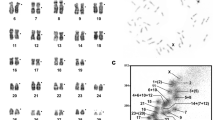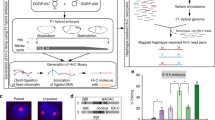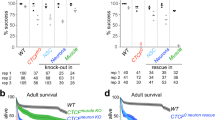Abstract
The homoeo box is a 180-base pair (bp) DNA sequence conserved in Drosophila homoeotic genes, which regulate early development1,2. These DNA sequences are present in open reading frames and have been identified in specific gene transcripts in Drosophila and Xenopus embryos3–5; they possess structural features in common with genes encoding some DNA-binding proteins6,7. Homologous homoeo box sequences have been detected in species ranging from insects and annelids to vertebrates2,5,8. The high degree of sequence conservation (70–90%) among different species suggests a strong evolutionary relationship and implies a common role in embryonic development. To test this hypothesis, one approach we have used is to examine the patterns of genetic organization of homoeo box sequences in mouse and human for any similarities; the second approach is to localize the chromosomal map positions of homoeo box sequences in the two species. A similar genomic organization and chromosomal distribution of homoeo box sequences would argue for a conserved function and might shed light on their mechanism of action. Here, we describe experiments which show that two homoeo box loci map, respectively, to evolutionarily related regions on mouse chromosome 11 and human chromosome 17.
This is a preview of subscription content, access via your institution
Access options
Subscribe to this journal
Receive 51 print issues and online access
$199.00 per year
only $3.90 per issue
Buy this article
- Purchase on Springer Link
- Instant access to full article PDF
Prices may be subject to local taxes which are calculated during checkout
Similar content being viewed by others
References
McGinnis, W., Levine, M., Hafen, E., Kuroiwa, A. & Gehring, W. J. Nature 308, 428–433 (1984).
McGinnis, W., Garber, R. L., Wirz, J., Kuroiwa, A. & Gehring, W. J. Cell 37, 403–408 (1984).
Hafen, E., Levine, M., Garber, R. L. & Gehring, W. J. EMBO J. 2, 617–623 (1983).
Hafen, E., Kuroiwa, A. & Gehring, W. J. Cell 37, 833–841 (1984).
Carrasco, A. E., McGinnis, W., Gehring, W. J. & DeRobertis, E. M. Cell 37, 409–414 (1984).
Shepherd, J. C. W., McGinnis, W., Carrasco, A. E., DeRobertis, E. M. & Gehring, W. J. Nature 310, 70–71 (1984).
Laughon, A. & Scott, M. P. Nature 310, 25–31 (1984).
Levine, M., Rubin, G. M. & Tjian, R. Cell 38, 667–673 (1984).
McGinnis, W., Hart, C. P., Gehring, W. J. & Ruddle, F. H. Cell 38, 675–680 (1984).
Rabin, M. et al. Cytogenet. Cell Genet. 38, 70–72 (1984).
Barker, P. E. et al. Proc. natn. Acad. Sci. U.S.A. 81, 5826–5830 (1984).
Francke, U. & Taggart, R. T. Proc. natn. Acad. Sci. U.S.A. 77, 3595–3599 (1980).
Roderick, T. H. et al. Cytogenet. Cell Genet. 37, 312–316 (1984).
Kamarck, M. E., Barker, P. E., Miller, R. L. & Ruddle, F. H. Expl Cell Res. 152, 1–14 (1984).
Church, R. L., SundarRaj, N. & McDougall, J. K. Cytogenet. Cell Genet. 27, 24–30 (1980).
Huerre, C. et al. Proc. natn. Acad. Sci. U.S.A. 79, 6627–6630 (1982).
McDougall, J. K., Kucherlapati, R. & Ruddle, F. H. Nature new Biol. 245, 172–175 (1973).
Elsevier, S. M. et al. Nature 251, 633–636 (1974).
Gross, S. Cytogenet. Cell Genet. 25, 161–164 (1979).
George, D. L., Phillips, J. A. III, Francke, U. & Seeburg, P. H. Hum. Genet. 57, 138–141 (1981).
Harper, M. E., Barrera-Saldana, H. A. & Saunders, G. F. Am. J. hum. Genet. 34, 227–234 (1982).
Zabel, B. U., Fournier, R. E. K., Lalley, P. A., Naylor, S. L. & Sakaguchi, A. Y. Proc. natn. Acad. Sci. U.S.A. 81, 4874–4878 (1984).
Frykberg, L. et al. Cell 32, 227–238 (1983).
Kozak, C. A. & Ruddle, F. H. Somat. Cell Genet. 3, 121–133 (1977).
McBreen, P., Orkwiszewski, K. G., Chern, C. J., Mellman, W. J. & Croce, C. M. Cytogenet. Cell Genet. 19, 7–13 (1977).
Green, M. C. Genetic Variants and Strains of the Laboratory Mouse (Fischer, New York, 1981).
Aleck, K. et al. Am. J. hum. Genet. 36, 41S (1984).
Handmaker, S. D., Robinson, L. D., Campbell, J. A., Chinwah, O. & Gorlin, R. J. Birth Defects orig. Artic. Ser. 13, (3D), 79–90 (1977).
Gorlin, R. J. & Langer, L. O. Jr Birth Defects orig. Artic Ser. 14, (6B) 193–197 (1978).
Svejcar, J. Clin. Genet. 23, 369–375 (1983).
Rigby, P. W. J., Dieckman, M., Rhodes, C. & Berg, P. J. molec. Biol. 113, 237–251 (1977).
Szabo, P., Elder, R., Steffensen, D. M. & Uhlenbeck, O. C. J. molec. Biol. 115, 539–563 (1977).
Author information
Authors and Affiliations
Rights and permissions
About this article
Cite this article
Rabin, M., Hart, C., Ferguson-Smith, A. et al. Two homoeo box loci mapped in evolutionarily related mouse and human chromosomes. Nature 314, 175–178 (1985). https://doi.org/10.1038/314175a0
Received:
Accepted:
Issue Date:
DOI: https://doi.org/10.1038/314175a0
This article is cited by
-
Organization and expression of mouse Hox3 cluster genes
Molecular and General Genetics MGG (1993)
-
Comparative map for mice and humans
Mammalian Genome (1992)
-
Mouse map of paralogous genes
Mammalian Genome (1991)
-
Comparative map for mice and humans
Mammalian Genome (1991)
-
Mouse chromosome 11
Mammalian Genome (1991)
Comments
By submitting a comment you agree to abide by our Terms and Community Guidelines. If you find something abusive or that does not comply with our terms or guidelines please flag it as inappropriate.



